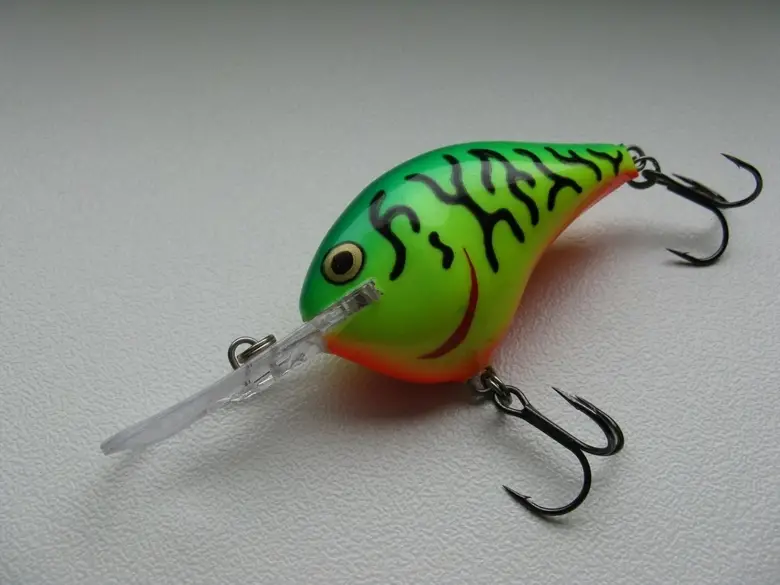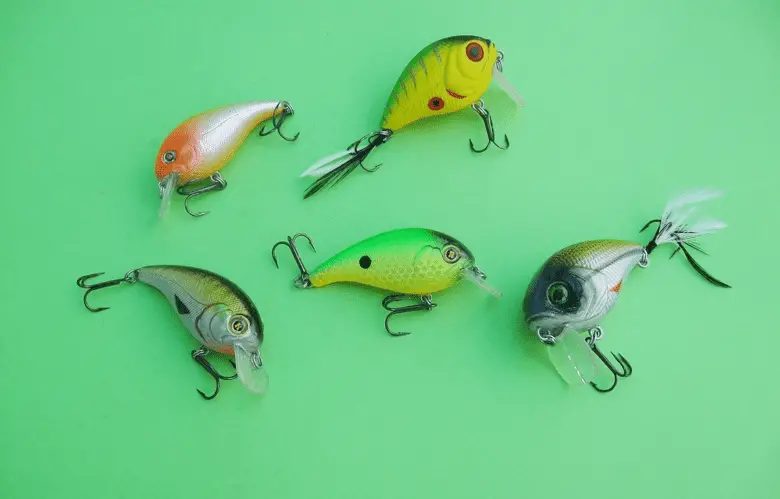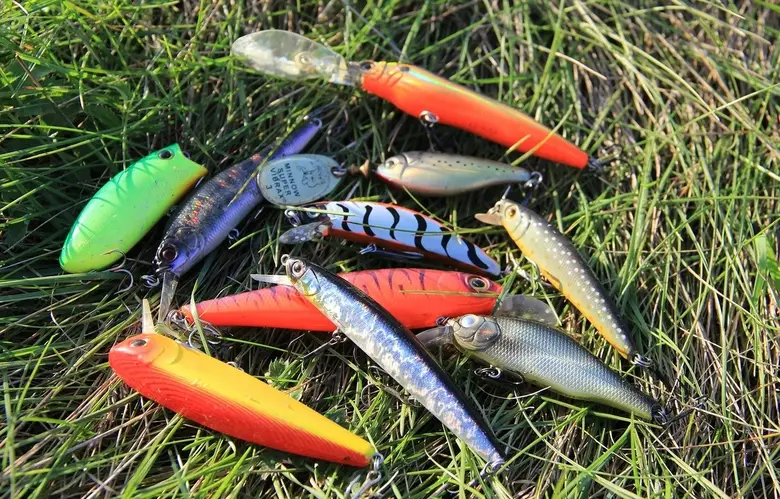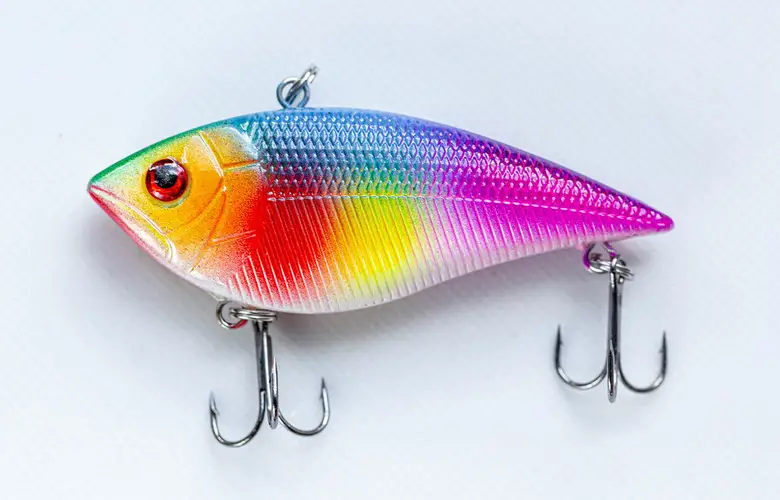It often feels to me that the last couple of decades has been all about soft plastics and cranks.
From having a few go-to plugs when I was a young guy, cranks have evolved into an obsession with so many styles, colors, and designs.
I’m not complaining, I love em. I just have to battle the cynical consumer inside me that reverts to the notion that lures are designed by marketing agencies to catch anglers.
Bottom line is that cranks are effective lures and useful for any fish that includes small baitfish in their diet.
They’re by and large an inshore lure and can be fished in freshwater and saltwater.
Let’s have a closer look at how to fish a crankbait. What exactly are they, where should you fish them, when, and what should you target?
Let’s get cranky.
Page Contents
What Is A Crankbait Lure?
I’ve just realized that I’ve never been asked this specific question before. What is a crankbait?
I’ve explained how to use cranks countless times but never had to explain what they are. I’ve stopped writing and pondered the question over a coffee.
How would I explain a crank to somebody who has never seen one and has no idea? That’s how I’ll approach it now – assume nothing and use simple terms.

Cranks are hard body lures, usually armed with twin trebles, having line anchor points on the top front third or the bill/bib/nose.
They have a distinct shape with a fat head and front section that tapers to the tail.
It’s their bulbous look, sort of tear-shaped if you were to hang it by its tail, which makes them quite distinct.
Sort of like a miniature cartoon whale – many of them, anyway.
Let’s put it this way. If you see a lure identical to my whale description above, the odds are good that it’s a crank.
However, they won’t necessarily all look like that
If you were to sit a stickbait, minnow, swimbait, jig, or popper next to a crankbait, you’ll clearly see that the shape of the crankbait is a standout; and it is a design through-line.
Your grandfather or your dad would probably still call them plugs. It’s an apt name, given their pluggy pudgy phenotype.
However, the term plug applies to any number of hard body lures, depending on where you come from and the era you cut your fishing teeth.
Just to confuse things further, lure names are often regional and generational.
And like everything fishing, definitive standards are very blurry to non-existent, and one man’s lipless crank is another man’s vibe.
Crank sizes range from 2 inches to 12 inches, with the big ones looking more like swimbaits.
I’m thinking now that if you hit a tackle shop, faced with a wall of lures, you’d probably be able to identify the cranks.
If you can’t…read the packet! You’ll probably have to anyway because there are at least four styles, and they all do different things.
Also Read: Should You Use Snaps For Fishing Crankbaits
Types of Crankbaits
Generally speaking, there are 5 types of crankbaits: shallow diving, square bill, medium diving, deep diving, and lipless.
There is a 6th style which is a soft body crank, which also comes in shallow, medium, deep diving, and lipless. It’s the construction material that’s different. They’re soft.
Again, this serves to confuse things because if you were able to name anything definitive about a crank, you could at least say it’s a hardbody. Not anymore.
Shallow Diving and Square Bill Cranks
As the name suggests, these lures are for targeting shallow waters. Shallow water is generally 0 to 8 feet, but square bills have become the standard for 0 to 5 feet.
Square bills are made for getting right into the cover, and fishing both hard and soft structures.
The design does favor the brave, and you can attack structures that you wouldn’t cast at normally for fear of hang up. However, be warned.
While square bills do handle the cover better than others, you will get hung up if you cast with a complete absence of caution.
They’re not magical miracle lures, and they will snag.
Medium Diving Cranks

Medium divers are great up to 10 feet or so. Keep in mind that these guys are great for shallower water too.
This happens because the collision with the river bed throws up sand and other sea stuff creating a commotion that attracts fish.
You can use a medium diver if you’re fishing a sandy, contoured bank that’s 5 to 6 feet deep.
Deep Diving Cranks
These guys work at 12 to 15 feet but can go even deeper in the hands of a skilled angler.
The technique is critical for deep diving cranks, and they should be worked in channels, drop-offs holes, and where submerged islands and rock piles sit.
Ideally, you want some contact with the river bed to create the noise, both visual and audible. It’s the commotion that alerts nearby fish to a possible feed.
Lipless Cranks
Lipless Cranks are perfect for grass and weed beds in the shallows. It can be tricky to master the technique to keep the hooks from fouling, but it’s well worth it, as the results can be outstanding.
Use the rod action, and lift the rod to keep it from getting completely consumed in the grass, lifting it, and retrieving it slowly, but erratically.
In the cooler months, lipless is also a great option in deeper water. Indeed, the technique is quite easy, and very much like working a vibe.
Erratic lifts, with slow drops, yo-yo style. Remember, speed is a killer in the cooler months, so take it easy, but keep it erratic.
See Also: 5 Best Crankbait Fishing Reels
When is the Best Time to Fish a Crankbait? Summer, Winter, or Fall?
Cranks are all-year lures. The critical thing is to understand the fish and how their behavior changes with the seasons.
For example, bass anglers should work the shallows with square bills and shallow divers in the spring and fall.
In the cooler months, bass will strike at medium and deeper places in the water column, so it’s worth working a lipless or billed crank around deeper cover.
It can be tricky to keep your lure down, and some weight addition might be a good idea.
Try led tape and experiment. Work the rocks, and structure. If you hit rocks (ideal) just pause a little and let the buoyancy work a little – it’s a classic pre-strike position.
For the salties, any crank, anywhere all year round. Get creative, and don’t get hung up about the fact you’re fishing a bass bait in a salt estuary.
It can be a great idea to up the size, perhaps using a crank you might use for a musky. They’re strong, robust, but might require trebles and rings with better salt credentials.
Literally, anything that takes baitfish is a target. Think critically and think creatively.
Keep in mind that saltwater anglers won’t have the same issues to concern themselves with such as seasonal bass behavior.
For freshwater anglers, the important thing to remember is the seasonal behavior of the fish you’re targeting. Adapt your crank selection and method to meet conditions.
What Are Crankbaits Good For?

I know it sounds ridiculous to say that they’re good for catching fish, but sometimes it is worth stating the obvious. Cranks can be super deadly on a range of fish.
Cranks are versatile as there’s a model to get you everywhere you need in the water column. And that’s what I like about cranks.
They’re also great all year round and have plenty of fresh and salt targets.
Cranks give you control. They’re not difficult to use and a little practice will see you extracting peak action while keeping it in the strike zone for a maximum period.
Cranks have great action built-in. However, it’s not a case of cast and retrieve. It’s up to the angler to generate the motions of the fish they mimic.
While a simple cast and retrieve might entice the bite, only considered retrieves, with the erratic moves of a baitfish, will encourage the alfa predators.
It’s a crankbait. And it’s all in the name. Ultimately, you crank it to make it work. For that reason, pretty well any hard body might be considered a crankbait.
What Kind of Fish Can You Catch with Crankbait?
Any fish that takes baitfish will attack a crank. A crank will work when fish are hard on the chew, or at times when they’re not hungry, and very lazy. Common targets include:
- trout
- salmon
- bass. Smallmouth and largemouth
- pike
- walleye
- perch
- musky
- panfish such as bluegill and crappie
- stripers
- drum
What Color of Crankbait is Best?
The color thing can be overwhelming and there’s plenty of local knowledge involved that may contradict standards and trends.
Colors that have been a guarantee can turn up nothing, whereas unlikely colors can set the bite on fire.
Experimentation is the key but there are some rules of thumb you can follow, and generally speaking, the pragmatic approach to color is often the most consistent.
When the water is clean and clear, match the hatch as best you can. Whatever your target has on the menu, it’s best to go for realism.
As an alternative, when the fish just won’t take your ‘perfect’ presentation, try a contrast. At times I’ve broken a stalemate with this approach.
With dark, stained, and dirty water, visibility drops significantly. In which case, strong colors allow a profile to stand out better.
I like heavy color contrast in such lures, with colors such as strong yellows with black or dark green features.
Of course, color is part of the story in murky waters.
You have to work your crank, ensuring vibration and sound via collision and erratic movements to entice fish to notice.
With eyes on it, the color will do its thing, enticing fish to strike mode.
Also Read: Best Crankbait Rods Reviewed
How to Fish With a Lipless Crankbait?

A lipless crank is very much like a vibe. Its wobble through the water creates the vibration that attracts the bite.
A slow and steady retrieve generates the action you need. Contact with the bottom is great, and an erratic lift, drop, and change of direction adds reality to your presentation.
A lipless can be worked as you would a jig, which is great for deeper water.
I simple yo-yo action is enough for the vibrations to attract fish. Often you’ll get hit on the drop, so be ready.
How To Use a Crankbait in Weeds?
Square bill cranks are great in the weeds and grass as they afford you extra protection from hang-ups.
The trick for fishing soft cover is in the rod. You want a rod that can pop your crank out of the cover. A crankbait rod with a little bit more backbone is ideal.
With a standard whippy crank rod, while ideal for hard cover, it’s more difficult to jerk the lure from the weeds.
How do you Fish a Crankbait from the Shore?
When fishing from the bank, the technique depends on whether you are fishing deep or shallow.
Long casts to a deep submerged structure require medium to deep divers. The fact you have to cast a distance is handy as it’s the length of your cast (coupled with the bill) that will determine your depth.
Fishing shallow is the square bill zone, and what you’re looking to do is bang submerged rocks in a sweeping action, followed by a pause.
This is great for lures that float or have neutral buoyancy.
Cast, crank, then sweep, then pause allowing the lure to rise from the rocks it has just hit. Then repeat.
A great way to get a feel with a visual is to work your crank right at your feet parallel to the bank.
You can see what it’s doing (provided there’s enough water clarity) then get to understand the feel, while looking at it.
This will help you to achieve a rhythm/action you can control by feel alone.
Sharing is caring!

